By Freeman Rogers, Omaya Sosa Pascual and Emmanuel Estrada López | Centro de Periodismo Investigativo
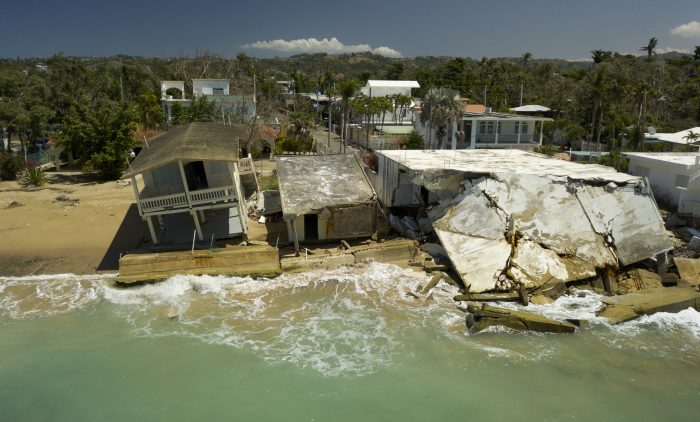

Rincón, Puerto Rico (Photo by Leandro Fabrizi Ríos)
Spanish version here.
Dinelle Henley fears for her native Cane Garden Bay, one of the most iconic and pristine beaches of the Caribbean.
Like much of the British Virgin Islands, the popular seaside village was devastated by winds, waves and flooding when the center of Hurricane Irma passed directly over the territory on September 6.
Eighty nautical miles to the west, Alexis Correa feels the same way. Although they do not know each other, they speak different languages and their governments are unrelated, he has also seen firsthand what the fury of a Category 4 hurricane is capable of doing to a small, vulnerable island. When Hurricane María devastated Puerto Rico with its 155-mile-per-hour winds on September 20 it swept away roofs, structures, bridges and roads all over the island.
But Correa has been watching a prelude to this destruction in his community for more than a decade. The ocean first claimed the social and cultural center of his Parcelas Suárez neighborhood in the municipality of Loíza. Then Hurricane María swept away the basketball court and the park. The places were an integral part of this community, one stricken by poverty, criminality, discrimination and limited social mobility, and its destruction has left residents with practically no options.
“Here the community board and residents used to meet, but we also used to celebrate weddings and ‘quinceañeros’,” Correa said as he looked at the ruins of the building, which also served as a childcare center before it was closed in 2002 because of the damage caused by erosion. “We moved to the court and the park, but María destroyed them. Now we don’t have a place to meet.”
In St. Croix, organic farmer Luca Gasperi is similarly distraught, but not surprised: He believes the back-to-back September storms that hit his native United States Virgin Islands (USVI) were consistent with other weather patterns that he had been noticing for years.
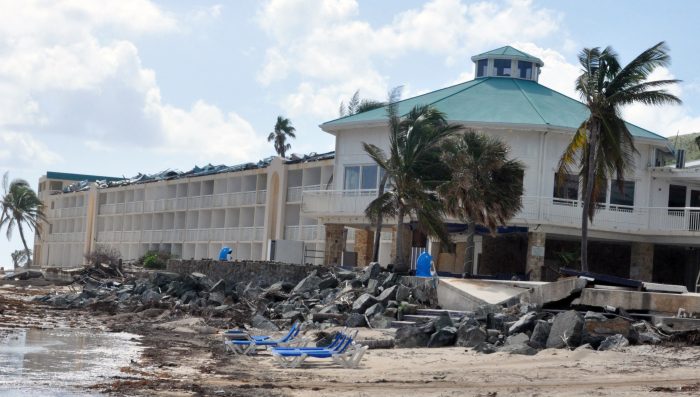

Destruction in St. Croix (Photo by Christina Kissoon)
“Everything is more intense,” he said as his wife Christina sold produce on a Saturday afternoon at the 40-acre farm they operate on his parents’ land.
Then he ticked off a list of evidence: A lengthy drought struck in 2015, rainstorms have been heavier, and for the first time in more than a decade of farming he suddenly is unable to grow broccoli. Another hurricane, he added, could be the last straw.
“For us, if it happens again…,” he said, his voice trailing off. “That’s the thing: The way these storms this year got so strong so quick—that’s nerve-racking.”
Henley, Correa and Gasperi blame rapid climate change due to global warming and government inaction for greatly exacerbating their islands’ losses, and they worry that the ocean and extreme weather events like Irma and María will continue to expose the fragility of their islands’ infrastructure and flawed construction practices.
Their stories are a snapshot of how climate change is not only eroding the coasts of these territories and other Caribbean islands, but actively destroying community life and economic activity in plain sight with little to no governmental action to protect citizens, according to a regional investigation by the Center for Investigative Journalism and half a dozen Caribbean media outlets.
Experts agree. Ramón Bueno, coauthor of one of the few existing studies on climate change in the Caribbean, said the scientific community agrees that the hotter air in the atmosphere caused by global warming carries more humidity that elevates the sea level and provokes stronger storms, with more rain and higher surges. These were among the conclusions of the most recent report from the United Nations’ Intergovernmental Panel on Climate Change (IPCC), its Fifth Assessment Report (AR5), published in November 2014. The IPCC, where more than 2,000 scientists from 195 member countries collaborate, is the world’s primary source of scientific information on climate change and its effects.
“While the number of hurricanes may not change much, or may even decrease somewhat, what is most probable with global warming is that we will see a greater amount of high category hurricanes,” Bueno said. The scientist worked at Tufts University Global Development and Environmental Institute (GDEI) and was a staff scientist at the Stockholm Environmental Institute, and since 2013 he has been an independent consultant specializing in climate change.
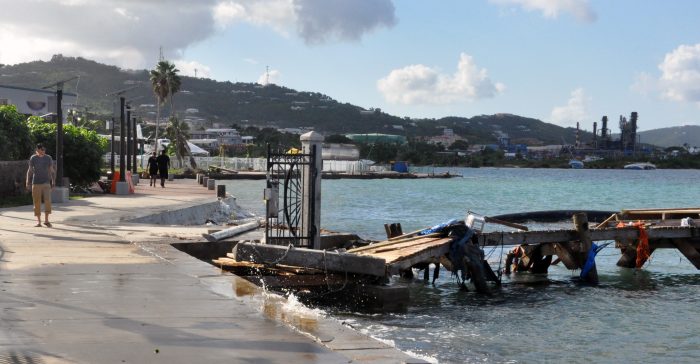

St. Croix (Photo by Christina Kissoon)
“While the number of hurricanes may not change much, or may even decrease somewhat, what is most probable with global warming is that we will see a greater amount of high category hurricanes,” Bueno said. The scientist worked at Tufts University Global Development and Environmental Institute (GDEI) and was a staff scientist at the Stockholm Environmental Institute, and since 2013 he has been an independent consultant specializing in climate change.
“The problem is that, like 2017 made quite clear, that only a few Category 4 or 5 hurricanes represent a very high threat to the sustainability of communities in the islands of the Caribbean. It is worse when a same place is hit by more that one [hurricane]. After María, even a mere tropical storm or Category 1 hurricane would be devastating,” he added.
Dr. Kerry Emanuel, professor of atmospheric science at Massachusetts Institute of Technology, who is currently working on two studies about the impact of hurricanes in the Caribbean, said that there is consensus on two issues about the effects of climate change: the sea-level is rising and the amount of rainfall is increasing. And both are set to cause serious hurricane flood damage in the Caribbean.
In the coastal town of Rincón, in the north Puerto Rico, Julian Rodriguez knew that in ten years many things could happen, but he didn’t see that the two family beach apartments —an investment of over $400,000— could be destroyed overnight. During Hurricane María, the sea undermined the foundations of Rincón Ocean Club II, a three-story condominium next to the beach, and his dream became salt and water, literally.
“If I am honest, I imagined that this would happen. I had seen that this had happened three times already, with tropical storms that passed through the south of Puerto Rico—even if they did not hit the island. And even if Rincón didn’t get a drop of rain, the waves came and the fence of the condominium was washed to sea. When they told me that a Category 4 hurricane was coming, I knew that was it. The shock of seeing it is different. But I knew it was coming,” he recalled.
When his family bought the two apartments, Julian remembers seeing —and playing on— a sandy beach of about 30 feet wide. It never occurred to him that the ocean would end up swallowing the building, which is just under 15 years old. “And many of those who have, or had, an apartment here, they still owe a mortgage. You buy this thinking that 30 or 40 years from now you will still have it,” he said.
Ten years ago, Ramón Bueno and his colleagues at Tufts GDEI — Cornelia Herzfeld, Elizabeth A. Stanton and Frank Ackerman — saw this coming. In their 2008 study The Caribbean and Climate Change: The Costs of Inaction, they warned that the two dozen island nations and territories of the Caribbean with their 40 million inhabitants were especially vulnerable to the effects of global warming though they have contributed little to the release of the greenhouse gases that drive the phenomenon.
The researchers looked at optimistic and pessimistic scenarios based on a study developed by IPCC, analyzing average hurricane damages, tourism losses and infrastructure damages due to sea-level rises from hurricanes, and projected $22 billion in losses to the Caribbean’s economy by year 2050 or 10% of the region’s Gross Domestic Product. Nonetheless, individual projections of losses vary much from island to island, with some in the range of 40% and Haiti at the top with 61%.
“As ocean levels rise, the smallest, low-lying islands may disappear under the waves. As temperatures rise and storms become more severe, tourism —the life-blood of many Caribbean economies— will shrink and with it both private incomes and the public tax revenues that support education, social services, and infrastructure,” the scientists said.
Now, concrete impact of rising sea levels and temperatures and extreme weather events is not a future projection, but a tough reality. In places like Puerto Rico, BVI, USVI, Dominica, Panama, Dominican Republic, and Haiti, CPI’s regional investigation documented ongoing floods, population displacement, significant loss of the shoreline, and impacts on tourism businesses that are already happening.
Palominito island, a popular tourism spot for boaters off the eastern coast of Puerto Rico, has almost disappeared.
Recent hurricanes have dramatically exacerbated coastal erosion and exposed the fragility of infrastructure and the potentially deadly impact on populations of the worst hit islands: Puerto Rico, BVI, USVI, Dominica, Barbuda and Saint Martin.
“We as a region now have to look particularly at the events of last year and the projections of the future that this is the new reality for the Caribbean, and we have to protect ourselves,” said Dr. Ulric Trotz, the deputy director and science advisor for the Caribbean Community Climate Change Centre in Belize.
Amid the catastrophic devastation that Irma wrought in the BVI, it is easy to forget that another natural disaster struck the territory about three weeks earlier.
As residents prepared for the annual August Emancipation Festival parade, the sky darkened and rain began to fall. Soon the parade was called off, although a handful of troupes performed anyway, dancing through the capital city of Road Town as thunder crashed and water poured down in sheets.
Over the next 24 hours, some 16 inches fell in parts of the territory, and the capital city and other areas flooded to a level that was unprecedented in recent memory.
Leaders have since dubbed the disaster a “100-year flood,” but the director of the BVI’s Department of Disaster Management, Sharleen Dabreo, pointed out that catastrophic floods have struck the territory on a seven-year cycle since 2003.
“It’s not just Irma and Maria: It’s that you have these flooding events triggered by these [weather] troughs, which is something that you didn’t have in the past,” DaBreo said, adding, “There needs to be a better relationship between the scientific community and the development planning elements of government.”
University of Puerto Rico geology professor and geographer Maritza Barreto Orta, who has conducted numerous studies on beach erosion in Puerto Rico and the Dominican Republic, agrees. In Puerto Rico, she found that between 1970 and 2010 the worst measured point had a net loss of 70 meters of shoreline, in the municipality of Loíza. Since 2011 the average annual loss rate of two meters has gone up to more than four meters in some areas.
A week after María, Barreto and her team visited 75% of Puerto Rico’s 1,225 beaches and visually documented significant erosion and flattening. The most striking case found was in La Boca sector in the municipality of Barceloneta, where the beach was reduced from its 60 meters (180 feet) to only four (12 feet). She is currently looking for state and federal funding to update the full study.
“I feel there is a lack of trust towards academia, and that is a serious problem because the government has to trust the data experts and scientists generate,” she said. “At the same time, academia should go to public hearings and make itself heard, because the knowledge we generate is important to public policy.”
The Political and Colonial Dilemma
According to Trotz, Bueno, Barreto and other scientists, the recent weather events clearly illustrate the effects of global warming in the region, which is highly dependent on tourism and suffers from a low level of agricultural activity and food sustainability.
Nonetheless, many of the countries and territories in the Caribbean are being overlooked by their governments and international organizations. CPI’s investigation found that only three —BVI, Cuba and Mexico— out of 13 countries and territories surveyed have climate change legislation in place and even in these places, building codes, environmental rules, and other regulations often are not followed.
It also found that there is not even reliable, standardized and up-to-date data on what is happening in about a dozen islands in the region in the databases of international organizations dedicated to studying climate change impact, such as the IPCC and the University of Notre Dame’s Global Adaptation Initiative, among others.
These islands —some of the most vulnerable in the world— have a crucial thing in common: they are so-called territories or colonies in the 21st century. They have no individual participation in the IPCC and other international organizations devoted to monitoring the impact of climate change around the world and proposing solutions.
They are forgotten islands, like about a dozen more in the Caribbean, and many of them belong to but are not part of the United States, England, Holland and France.
There is little to no information about their indicators in IPCC, UN, and ND-Gain Index databases. In some cases there is not even a slot with their names. That is the case with the ND-Gain Index, which uses UN data and shows US information in the case of Puerto Rico —misleadingly portraying that the island is doing great— and no information at all in the case of BVI, USVI and the rest of the Caribbean territories.
Currently, 86 experts from 39 countries are working on IPCC’s next world climate change assessment report (AR6), which will be published in September 2018. Only two of these experts are from the Caribbean, both from Cuba.
“It’s just terrible. The neglect of that whole part of the world is shocking,” Dr. Emanuel from MIT said.
In 2007, the Puerto Rico House of Representatives discussed PC 3414, the first bill related to climate change that was presented in that body. It was not approved in the Special Commission on Global Warming and Security, but just the possibility of the proposal being considered at a legislative level was enough for gasoline distributors in Puerto Rico —the Gasoline Retailers Association (ADG), Peerless Oil & Chemicals and Caribbean Petroleum Refining— to oppose the government preparation of a Plan for the Reduction of Gas Emissions and Control of Global Warming and to question Puerto Rico’s adherence to the Kyoto Agreement of 1997.
In the USVI, similar stalled measures include a climate change strategy that was required by a 2015 executive order but never materialized.
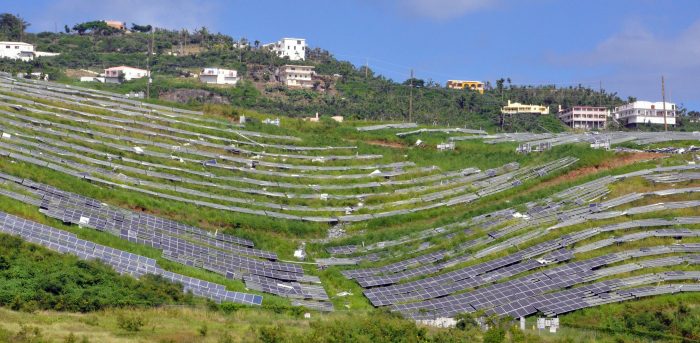

St. Thomas solar farm near Charlotte Amalie, the capital of the United States Virgin Islands, was largely destroyed by hurricanes Irma and Maria. (Photo by Christina Kissoon)
The BVI, on the other hand, now appears on paper to be a poster child for preparedness, thanks mostly to steps taken in the past decade. In 2012, the territory’s Cabinet adopted a Climate Change Adaptation Policy, setting dozens of specific deadlines for mitigation measures that in many cases had been promised for decades. Then in 2015, the BVI became the first in the region to adopt a legal framework for a trust fund designed to raise money to prepare for global warming.
USVI and the BVI all offer striking examples of the problems associated with climate change and the dangerous consequences for their people and their economies. The islands’ policymakers, legislators and governors, and their imperial owners, have known for decades about the vulnerability of their infrastructure and the increased dangers that climate change pose to these islands and populations. And for decades they have debated, legislated and talked about it. But words have not translated into action.
For instance, the Puerto Rican Legislature has seen more than 45 measures between 2005 and 2018 directed at putting into place mitigation and adaptation measures and dealing with the urgency of coastal erosion. Only one has passed: Climate Change Law 246, which was signed by Governor Aníbal Acevedo Vilá in 2008. It did not last eight months. It was officially repealed less than two years later by his opposing party successor Luis Fortuño Burset, and its provisions were never enacted before that.
However, at least two-thirds of the deadlines listed in the 2012 policy have already been missed, and the trust fund is not yet operational, the CPI found. And although BVI leaders say that the promised reforms are in the works, scientists and policymakers who recall the repeated failure of such efforts over the past quarter century worry that the territory’s elected officials —who are responsible for passing laws and managing the territory’s internal affairs— will be unable to muster the political will to see them through.
Such concerns are echoed throughout the region, even though experts say that comprehensive measures are essential for protecting islands from climate change and for helping them access badly needed international funding.
“We only start to talk about resilience when we have a big event,” Dr. Trotz said. “Post-disaster, there’s a lot of rhetoric, a lot of activity and whatnot, and then it fades. So there’s a big challenge: We can’t move ahead significantly without the political direction, without the political will.”
The experience of the BVI, the USVI and Puerto Rico shows why failure to take decisive action could be catastrophic. Policymakers and scientists say that the 2017 hurricanes and other recent weather events have exposed decades-old shortcomings in the territories’ development frameworks, building rules, environmental laws, energy practices and other areas that have left them increasingly vulnerable to global warming.
In Puerto Rico, María put at risk the lives of the territory’s 3.5 million citizens, caused a death toll that could exceed 1,000 deaths, forced the displacement of 183,000 citizens who left the island, and directly impacted the tourism industry, one of the government’s few bets to relaunch the badly damaged economy. The whole electrical grid of the island collapsed, more than 472,000 houses were severely damaged, and more than 90,000 families were left without a roof.
Most of the population was left in the dark and without communications for four months and was exposed to serious health hazards like contaminated water and deficient hospital services. More than six months after the storm, there are still 50,000 households and businesses without electricity, and power outages and water problems are common all over the island.
The USVI got a one-two punch. Irma devastated much of St. Thomas and St. John, and about two weeks later, María hit the southernmost island of St. Croix. Both of the territory’s main hospitals were mostly destroyed, and more than 400 patients were evacuated to the mainland US. Thirteen schools were closed, more than 100,000 of the territory’s 103,000 residents lost power, and most major resorts were severely damaged.
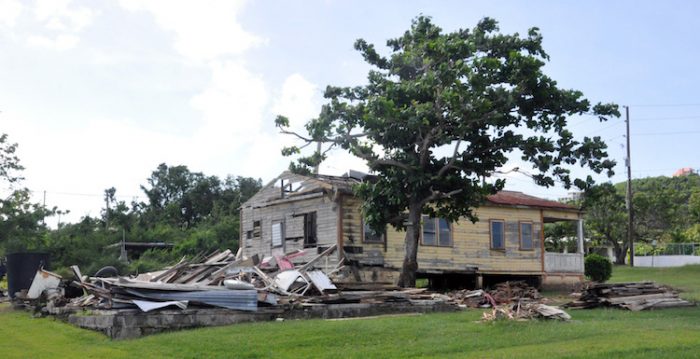

A home in St. Croix (Photo by Freeman Rogers)
Irma wrought similar havoc in the BVI, where about 22 percent of the 28,000 population was displaced and an estimated 70 percent of buildings suffered damage, with many of those —including some that housed government offices— totally destroyed.
Since the storm, no major resort has fully reopened—a serious blow in a territory where tourism generates more than 30 percent of the gross domestic product and directly employs one in three people. As of March 1, the total number of hotel rooms available in BVI was 336, compared to 2,700 before Irma. The yacht charter industry was hit hard too: Available berths at sea as of March 1 were 1,584, compared to 3,800 before the storm.
Other islands in the storms’ path suffered similar losses, including Dominica, St. Martin and Barbuda, which was hit so hard that all of its approximately 1,800 residents evacuated.
All these islands are far from recovering from Irma and María, and the new hurricane season is already about to begin in less than two months.
“Our natural resource infrastructure —things like mangroves, wetlands, natural drainageway; the key things that are really there to help storm protection, flooding— we’ve basically destroyed it all before this happened,” said Dr. Shannon Gore, a BVI biologist who serves on the board of the territory’s recently appointed Climate Change Trust Fund. “And this basically exposed the fact that we shouldn’t have done that. And if this isn’t a wakeup call, nothing else is really.”
Cane Garden Bay, for instance, still appeared pristine before the storm, but for decades it had faced mounting pressures that weren’t obvious to the tens of thousands of tourists who annually flocked to its sandy, palm-tree-lined shore. Mangroves and other wetlands around the village have been damaged or destroyed by patchwork development, exacerbating flooding and runoff from poorly protected road and construction sites, Dr. Gore explained. That runoff, in turn, has damaged reefs that might have better protected the shoreline from the waves during Irma.
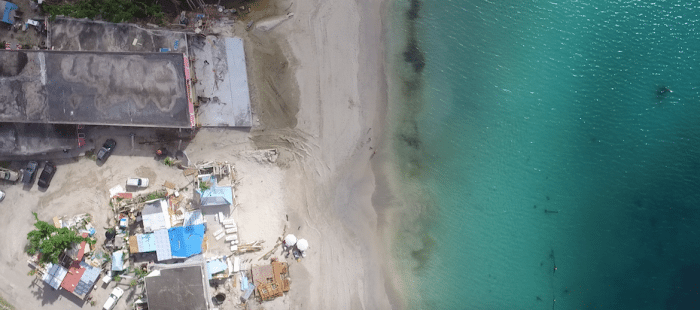

Cane Garden Bay in Tortola (Photo by Christina Kissoon)
In the same way, iconic beach bars —many of which were built in contravention of a planning guideline that prohibits construction within 50 feet of the high water mark— have contributed to erosion, and the village’s sewage system has been overworked and under-functioning for years.
Irma served as a stark reminder of the dangerous exposure exacerbated by such issues. All the beach bars there were severely damaged —if not totally obliterated— and the government had to temporarily ban swimming because of high levels of bacteria in the water caused in part by the faulty sewage system. Although some bars have since reopened and others are rebuilding, the shoreline often remains empty and tourists are typically taken instead to an undeveloped beach that is not lined with damaged buildings and other debris.
Puerto Rico faced a similar situation. Many beaches were closed because of the high levels of bacteria, and cement structures on the shoreline crumbled in some areas.
There’s a lesson to be learned from Cane Garden Bay’s plight, according to BVI ecologist Clive Petrovic.
“If people want to protect what they build there now, then clean the water so that the corals can grow and rebuild the coral reef outside,” Mr. Petrovic said, adding that coral is a primary source for the sand on many BVI beaches. “You look at nature and you look at how does nature solve a problem. And the way nature protects shorelines is with reefs.”
In spite of its challenges, the BVI has recently committed to comprehensive reform in the midst of a much broader global push.
In 2009, the world’s richest nations met in Copenhagen, Denmark, and pledged to provide $100 billion in funding to help developing countries prepare for global warming by 2020. That commitment was reaffirmed under the Paris Agreement in 2015.
But donor countries want to ensure that those funds are well spent.
“The donors are really looking for the countries to get their house in order,” said George de Berdt Romilly, a Canada-based environmental lawyer who has consulted extensively on climate change initiatives throughout the Caribbean and South Pacific. “This is not a blank cheque: They want to see … national strategies and policies approved at a very high level which really articulate the vision or the roadmap for going forward.”
The BVI has stayed ahead of the curve. A 2010 green paper was followed in 2011 by a tourism impact assessment. And in 2012, the territory’s Cabinet adopted a comprehensive Climate Change Adaptation Policy, which included deadlines in four years for about 140 goals ranging from environmental legislation to development guidelines to energy policy to agricultural and fishing reforms.
But by 2018, no more than a third of the goals has been met, the CPI has found.
Leaders argue that such measures take time and point to a variety of resilience projects being implemented by the government and other stakeholders, including a recent shoreline revetment in Cane Garden Bay, efforts to make schools and health facilities more eco-friendly and resilient, and flood mapping studies. But conservationists and technocrats say that history shows a tendency for BVI legislators to brush aside the difficult comprehensive reforms that are necessary to fundamentally change the way the territory does business on a day-to-day level.
Indeed, the unfulfilled goals listed in the climate change policy include dozens of measures that have been promised for more than a decade, such as a national development plan that has been in the works since the 1990s; environmental legislation and planning regulations that politicians have pledged to pass nearly every year since the mid 2000s; and long overdue updates to the 18-year-old building ordinance, among others.
BVI’s primary elected officials, Premier Dr. Orlando Smith and Deputy Premier Dr. Kedrick Pickering, who is the minister of natural resources and labor, did not respond to interview requests, but the BVI’s United Kingdom-appointed governor, Gus Jaspert, said that he and the UK are pushing for the elected leaders of the territory to act quickly.
“It needs to be the government here making those changes,” Mr. Jaspert said. “To be honest, I find it disappointing that a territory that is so naturally blessed in terms of its environment doesn’t have much in the way of alternative energy… doesn’t have good recycling or energy efficiency, so I 100-percent support the government’s drive to do more on that.”
But Mr. Romilly said that the UK isn’t necessarily putting its money where its mouth is.
“When they introduced this announcement that the international community is going to finance climate change programming with this $100 billion commitment, the British government put in place a carbon levy on airline travel,” he said, adding that half of that tax initially was promised for destination countries, including ones in the Caribbean. “The money has been collected for some years, but [the British government] have not made good on that commitment to make the 50 percent available directly to the countries where the travellers are going.”
But even when international funding is available, he added, donor countries and other contributors also want in place a mechanism to effectively administer it, such as the BVI’s trust fund, which is to be operated by an independent board.
Thanks in large part to a regional push by the Caribbean Community (Caricom) Climate Change Center, 10 of 15 of its full members —and the five British overseas territories that are associate members— have drafted a climate change policy or strategy. But they have seen varying levels of success officially adopting them at the Cabinet level of government, and so far only the BVI and Antigua and Barbuda have passed legislation to establish the sort of independent fund that donors want, Mr. Romilly said.
When there has been progress, it often has been patchy. Dominica, for instance, first adopted a climate change adaptation strategy in 2002, but many of its goals weren’t met, according to Mr. Romilly.
“The government had very limited resources, so where there was action it was because there was funding provided… but there was slippage where funding could not be mobilized,” he said.
And although the country’s government adopted a Low-Carbon Climate-Resilient Development Strategy in 2012, he said, it still hasn’t passed a bill drafted in 2014 to establish a trust fund—in spite of Dominica Prime Minister Roosevelt Skerrit’s repeated promises to take decisive action after Hurricane Maria devastated the country.
“Even though the Prime Minister has committed himself to being the first climate resilient country in the region, and it has been made clear to the government of Dominica that they need to have this legislation passed to do this, they have not got round to passing this legislation,” said Mr. Romilly, who helped draft the strategies and the bill.
He added that governments often don’t pass such measures until they are required to do so in order to obtain international funding.
“Unless there’s funding, there’s invariably very little action,” he said, adding that Dominica likely will pass the bill soon in order to access funding for a resilience project that is in the works.
In spite of such hitches, however, the Caribbean Community member countries in general are ahead of many of their neighbors, thanks in part to their collaborative efforts, Mr. Romilly said.
“The rest of the region is really trying to play catch-up, and of course that was fairly successful [on U.S. territories] under the Obama administration because there was a recognition of climate change as an issue,” he said. “However, in the current administration there’s been obviously a complete turnaround on that one.”
In the case of Puerto Rico, there is not even a climate change plan in place, and governor Ricardo Rosselló has said very little. He did not accept multiple requests for interview for this story and since Hurricane María’s devastation, has only devoted two public sentences to the issue, during his yearly State of the Commonwealth Address to Puerto Rico’s Legislature on March 5.
“The time has come to work on a holistic vision of the environment and the impact climate change has in Puerto Rico. I will support the measures you produce in this body to address this problem,” he said.
At the same time, he promoted new housing construction through economic incentives in an island that is bedridden by debt, abandoned properties and migration.


